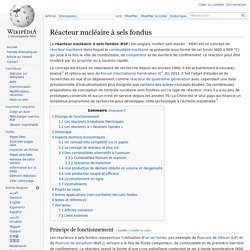

Search Results. Loading [MathJax]/extensions/mml2jax.js New Search » Sign up / Log in Deutsch Corporate edition Skip to: Main content Side column Download Subscribe to this page via RSS Download Download search results (CSV) Your download will be capped at 1000 items Page %P Close Plain text 1,165 Result(s) within English Book Relevance Newest First Oldest First previous Page is not a valid page number.

Between is not a valid date range. Your search also matched 133,634 preview-only Content is preview-only when you or your institution have not yet subscribed to it. Encyclopedia of Geropsychology.
Analyse multicritères. Physique. Divers. Réacteur nucléaire à sels fondus. Un article de Wikipédia, l'encyclopédie libre.

Le réacteur nucléaire à sels fondus (RSF) (en anglais, molten salt reactor : MSR) est un concept de réacteur nucléaire dans lequel le combustible nucléaire se présente sous forme de sel fondu (600 à 900 °C) qui joue à la fois le rôle de combustible, de caloporteur et de barrière de confinement. Le réacteur peut être modéré par du graphite ou à neutron rapide. Le concept est étudié en laboratoire de recherche depuis les années 1960. Il est actuellement à nouveau évalué[1] et retenu au sein du Forum International Génération IV[2].
En 2011, il fait l'objet d'études et de recherches en vue d'un déploiement comme réacteur de quatrième génération avec cependant une date prévisionnelle d'industrialisation plus éloignée que certains des autres concepts étudiés. Principe de fonctionnement[modifier | modifier le code] Le combustible fissile peut être de l'uranium 235, du plutonium ou de l'uranium 233, issus de la conversion du thorium.
Experimental archaelogy. Funny. Informatique. Maths. Raytheon XOS 2: second generation exoskeleton - Image 37 of 45. The widespread usage of exoskeletal robotics to augment human beings moved a step closer this week when Raytheon demonstrated its second generation Exoskeleton, the XOS 2.

The new robotic suit (think of it as wearable robot guided by a human brain) is lighter, faster and stronger than the original proof-of-concept XOS 1, yet uses half the power. While Raytheon's development is primarily focused on military usage, exoskeletons for the mobility-impaired are already at market and industrial exoskeletons from Japan, Korea and Isreal are not far behind. One day in the not-too-distant future, one of these suits will enable us all to have superhuman strength, speed and endurance.
View all The XOS 2 enables its wearer to easily lift 200 pounds several hundred times without tiring and repeatedly punch through three inches of wood. The XOS 2 robotics suit is being designed to help with the many logistics challenges faced by the military both on and off the battlefield. The Raytheon XOS 2 in detail. Honda’s prototype walking assist devices to go on show in the US - Image 1 of 12. April 16, 2009 With increasing numbers of post-war baby boomers beginning to face old age, devices assisting people remain mobile as they grow older will become big business.

Honda, which started out making motorcycles, has anticipated the needs of an aging population and invested heavily in mobility robotics research. The company is planning to demonstrate its prototype walking assist devices as part of a technical exhibition at the 2009 Society of Automotive Engineers (SAE) World Congress, at Detroit's Cobo Center, from April 20 to 23.
Prior to the Detroit event, Honda plans to put the devices through their paces for media in New York. View all Mobility robotics research Honda began researching walking assist devices in 1999, aimed at assisting people with limited or reduced mobility. Stride Management Assist Stride Management Assist is a lightweight, wearable device suited to people with weakened leg muscles, but who can still manage to walk on their own. Key specifications. Company: Time Magazine Names the XOS 2 Exoskeleton "Most Awesomest" Invention of 2010. Last updated: 10/27/2011* Raytheon’s second-generation exoskeleton (XOS 2), essentially a wearable robotics suit, has been named one of the Best Inventions of 2010 by Time Magazine .

The suit was unveiled for the first time in September during an event at the company’s Salt Lake City research facility. XOS 2 is lighter, stronger and faster than its predecessor, yet it uses 50 percent less power, and its new design makes it more resistant to the environment. The wearable robotics suit is being designed to help with the many logistics challenges faced by the military both in and out of theater.
The Miracle Drug That Kills All Cancers. Comment fait-on pour entrelacer le grillage des clôtures? by Don White. The Higgs Boson, AKA the God Particle, Explained with Animation.